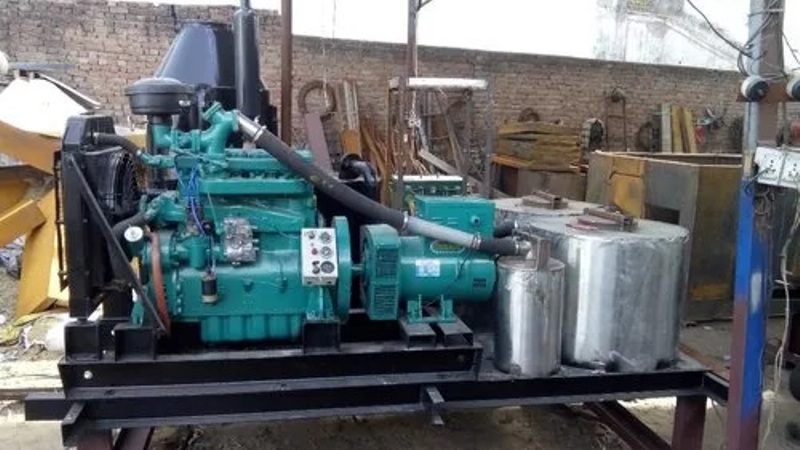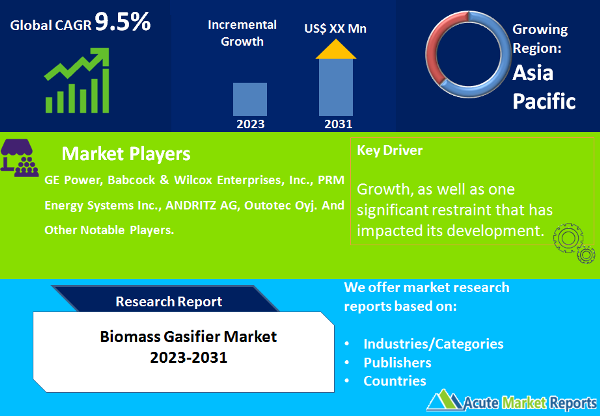
The biomass gasifier market is expected to grow at a CAGR of 9.5% during the forecast period of 2025 to 2033, due to various driving factors that have contributed to its expansion. In this comprehensive overview, we will delve into three primary drivers that have propelled the market's growth, as well as one significant restraint that has impacted its development. The biomass gasifier market has experienced significant growth due to factors such as the growing demand for renewable energy sources, supportive government policies, and a focus on waste management and the circular economy. However, high initial investments and technology barriers pose significant restraints. As the market continues to evolve, technological advancements and supportive policies are expected to fuel the adoption of biomass gasifiers as a sustainable and renewable energy solution.

Growing Demand for Renewable Energy Sources
The biomass gasifier market has been driven by the increasing demand for renewable energy sources. As concerns about climate change and environmental sustainability rise, there has been a significant shift towards utilizing renewable energy to reduce greenhouse gas emissions and combat the negative impacts of fossil fuels. Biomass gasification offers a cleaner and more sustainable alternative by converting organic materials, such as agricultural waste, forestry residues, and municipal solid waste, into a clean-burning gas called syngas. These syngas can be used for electricity generation and as a feedstock for biofuels, providing a greener energy solution. With governments and industries worldwide adopting renewable energy targets, the demand for biomass gasifiers is expected to witness significant growth during the forecast period.
Government Incentives and Supportive Policies
The growth of the biomass gasifier market has been influenced by the implementation of government incentives and supportive policies to promote renewable energy adoption. Many countries have introduced financial incentives, tax credits, and feed-in tariffs to encourage the use of biomass gasifiers for power generation and industrial applications. Additionally, supportive policies, such as renewable portfolio standards and energy efficiency targets, have further boosted the demand for biomass gasifiers in the energy sector. These government initiatives have created a favorable business environment for the biomass gasifier industry, attracting investments and driving technological advancements. As governments continue to prioritize renewable energy integration, the market for biomass gasifiers is expected to witness sustained growth in the coming years.
Rising Focus on Waste Management and Circular Economy
The increasing focus on waste management and the circular economy has played a significant role in driving the adoption of biomass gasifiers. Biomass gasification offers a viable solution for converting various types of organic waste into valuable energy products. By gasifying waste materials, such as agricultural residues, wood waste, and food scraps, biomass gasifiers contribute to waste reduction, landfill diversion, and the generation of renewable energy. This aligns with the principles of the circular economy, where resources are recycled and reused to minimize waste and promote sustainable development. As waste management becomes a global priority and circular economy practices gain momentum, the demand for biomass gasifiers is expected to grow as a sustainable waste-to-energy solution.
High Initial Investment and Technology Barriers
One significant restraint that has affected the biomass gasifier market is the high initial investment and technology barriers associated with biomass gasification projects. Establishing a biomass gasification plant requires considerable capital investment for equipment, infrastructure, and operational costs. Additionally, the technology involved in biomass gasification is complex and requires skilled expertise for design, installation, and operation. Small-scale projects, in particular, face challenges in securing funding and overcoming technical barriers, which can deter potential investors and hinder market growth. To address this restraint, research and development efforts are focused on optimizing biomass gasifier technologies and reducing overall project costs to make them more financially viable.
Market Segmentation by Type: Fluidized Bed Gasifiers Dominates the Market
In terms of type, the biomass gasifier market can be segmented into updraft gasifiers, downdraft gasifiers, and fluidized bed gasifiers. Among these, fluidized bed gasifiers are expected to witness both the highest CAGR during the forecast period of 2025 to 2033 and the highest revenue in 2024. Fluidized bed gasifiers offer several advantages, including better fuel flexibility, higher gasification efficiency, and reduced tar formation compared to other types. The versatility and efficiency of fluidized bed gasifiers make them popular choices for a wide range of biomass feedstocks and applications, driving their market growth.
Market Segmentation by Capacity: Medium and Large-Scale Gasifiers Promise Significant Potential
Based on capacity, the biomass gasifier market can be segmented into small-scale, medium-scale, and large-scale gasifiers. Both medium-scale and large-scale gasifiers are expected to witness both a significant CAGR during the forecast period of 2025 to 2033. Medium-scale gasifiers are suitable for distributed energy systems and industrial applications, providing an efficient and cost-effective solution for producing heat and power. Large-scale gasifiers, on the other hand, are ideal for centralized power generation and industrial facilities, catering to higher energy demands. As the demand for biomass-based power generation and industrial applications grows, both medium-scale and large-scale gasifiers are projected to contribute significantly to the market's revenue.
APAC to Promise Significant Opportunities During the Forecast Period
In terms of geographic segmentation, Europe is expected to be the leading market for biomass gasifiers in terms of both CAGR and revenue during the forecast period. The region's dominance can be attributed to the strong focus on renewable energy targets and supportive policies for biomass utilization. Additionally, Europe has a well-established biomass supply chain and extensive experience in biomass gasification projects, further driving market growth. Meanwhile, the Asia-Pacific region is anticipated to experience the highest CAGR during the forecast period. Factors such as rapid industrialization, increasing energy demand, and favorable government initiatives to promote clean energy are driving the adoption of biomass gasifiers in the region. Moreover, the presence of emerging economies with significant biomass resources further supports the market's expansion in Asia-Pacific.
Market Competition to Intensify during the Forecast Period
The biomass gasifier market is competitive, with several key players operating in the global landscape. Some of the top players in the market include GE Power, Babcock & Wilcox Enterprises, Inc., PRM Energy Systems Inc., ANDRITZ AG, and Outotec Oyj. These companies have a strong global presence and offer a wide range of biomass gasifier solutions for various applications. To maintain their competitive edge, these players focus on research and development to enhance gasifier efficiency, expand their product portfolios, and cater to diverse customer needs. Additionally, they actively engage in strategic collaborations and partnerships to strengthen their market presence and explore new market opportunities. As of 2025, the biomass gasifier market has witnessed substantial growth, and these top players have capitalized on market opportunities. Looking ahead to the forecast period from 2025 to 2033, it is expected that these players will continue to dominate the market and drive its growth through continued innovation and strategic initiatives.
Historical & Forecast Period
This study report represents analysis of each segment from 2023 to 2033 considering 2024 as the base year. Compounded Annual Growth Rate (CAGR) for each of the respective segments estimated for the forecast period of 2025 to 2033.
The current report comprises of quantitative market estimations for each micro market for every geographical region and qualitative market analysis such as micro and macro environment analysis, market trends, competitive intelligence, segment analysis, porters five force model, top winning strategies, top investment markets, emerging trends and technological analysis, case studies, strategic conclusions and recommendations and other key market insights.
Research Methodology
The complete research study was conducted in three phases, namely: secondary research, primary research, and expert panel review. key data point that enables the estimation of Biomass Gasifier market are as follows:
Market forecast was performed through proprietary software that analyzes various qualitative and quantitative factors. Growth rate and CAGR were estimated through intensive secondary and primary research. Data triangulation across various data points provides accuracy across various analyzed market segments in the report. Application of both top down and bottom-up approach for validation of market estimation assures logical, methodical and mathematical consistency of the quantitative data.
| ATTRIBUTE | DETAILS |
|---|---|
| Research Period | 2023-2033 |
| Base Year | 2024 |
| Forecast Period | 2025-2033 |
| Historical Year | 2023 |
| Unit | USD Million |
| Segmentation | |
Type
| |
Category
| |
Capacity
| |
Application
| |
|
Region Segment (2023-2033; US$ Million)
|
Key questions answered in this report